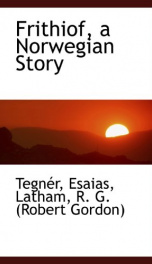Tegnér Esaias

Esaias Tegnér (Kyrkerud, Värmland 13 November 1782 (1782-11-13) – 2 November 1846 (1846-11-03)), was a Swedish writer, professor of Greek language, and bishop. He was during the 19th century regarded as the father of modern poetry in Sweden, mainly through the national romantique epos Frithjof's Saga. He has been called Sweden's first modern man. Much is known about him, and he also wrote openly about himself. His father was a pastor, and his grandparents on both sides were peasants. His father, whose name had been Esaias Lucasson, took the surname of Tegnérus—altered by his fifth son, the poet, to Tegnér—from the village of Tegnaby in the province of Småland, where he was born. In 1792 Tegnérus died. In 1799 Esaias Tegnér, hitherto educated in the country, entered Lund University, where he graduated in philosophy in 1802, and continued as tutor until 1810, when he was elected Greek lecturer. In 1806 he married Anna Maria Gustava Myhrman, to whom he had been attached since his earliest youth. In 1812 he was named professor, and continued to work as a lectuer in Lund until 1824, when he was made bishop of Växjö. At Växjö he remained until his death, twenty-two years later. Tegnér's early poems have little merit. He was comparatively slow in development. His first great success was a dithyrambic war-song for the army of 1808, which stirred every Swedish heart. In 1811 his patriotic poem Svea won the great prize of the Swedish Academy, and made him famous. In the same year was founded in Stockholm the Gothic League (Götiska förbundet), a sort of club of young and patriotic men of letters, of whom Tegnér quickly became the chief. The club published a magazine, entitled Iduna, in which it printed a great deal of excellent poetry, and ventilated its views, particularly as regards the study of old Icelandic literature and history. Tegnér, Geijer, Afzelius, and Nicander became the most famous members of the Gothic League. The majority of the many poems from Tegnér in his little room in Lund are short, but some are in lyrics. They are today shown to visitors as the Tegnér museum. His celebrated Song to the Sun dates from 1817. He completed three poems of a more ambitious character, on which his fame chiefly rests. Of these, two, the romance of Axel (1822) and the delicately-chiselled idyl of Nattvardsbarnen ("The First Communion," 1820), translated by Longfellow, take a secondary place in comparison with Tegnér's masterpiece, of worldwide fame. In 1819 he also became a member of the distinguished Swedish Academy, on seat 8. In 1820 he published in Iduna fragments of an epic on which he was working: Frithjof's saga (The Story of Frithiof). In 1822 he published five more cantos, and in 1825 the entire poem. Already before its last canto it was famous throughout Europe; the aged Goethe took up his pen to commend to his countrymen this "alte, kräftige, gigantischbarbarische Dichtart," and desired Amalie von Imhoff to translate it into German. This romantic paraphrase of an ancient saga was composed in twenty-four cantos, all differing in verse form, modelled somewhat, it is only fair to say, on an earlier Danish masterpiece, the Helge of Oehlenschläger. Frithjof's saga was during the 19th century the best known of all Swedish productions; it is said to have been translated twenty-two times into English, twenty times into German, and once at least into every European language. It is far from satisfying the demands of more recent antiquarian research, but it still is allowed to give the freshest existing impression, in imaginative form, of life in early Scandinavia. In later years Tegnér began, but left unfinished, two important epical poems, Gerda and Kronbruden. The period of the publication of Frithjof's saga (1825) was the critical epoch of his career. It made him one of the most famous poets in Europe; it transferred him from his study in Lund to the bishop's palace in Växjö; it marked the first breakdown of his health, which had hitherto been excellent; and it witnessed a singular moral crisis in the inner history of the poet, about which much has been written, but of which little is known. Tegnér was at this time passionately in love with a certain beautiful Euphrosyne Palm, the wife of a town councillor in Lund, and this unfortunate passion, while it inspired much of his finest poetry, turned the poet's blood to gall. From this time forward the heartlessness of woman is one of Tegnér's principal themes. It is a remarkable sign of the condition of Sweden at that time that a man without a Christian heritage, and of little interest in religious matters, should be offered and should accept a bishop's crosier. He did not hesitate in accepting it: it was a great honour; he was poor; and he was anxious to get away from Lund. No sooner, however, had he begun to study for his new duties than he began to regret the step he had taken. It was nevertheless too late to go back, and Tegnér made a respectable bishop as long as his health lasted. In 1835, he was elected a member of the Royal Swedish Academy of Sciences. But he became moody and melancholy; as early as 1833 he complained of fiery heats in his brain, and in 1840, during a visit to Stockholm, he suddenly became insane. He was sent to an asylum in Schleswig, and early in 1841 he was cured, and able to return to Växjö. It was during his convalescence in Schleswig that he composed Kronbruden. He wrote no more of importance; in 1843 he had a stroke of apoplexy, and on 2 November 1846 he died in Växjö. English
do you like this author?
What readers are saying
What do you think? Write your own comment on this book!
write a commentWhat readers are saying
What do you think? Write your own comment on this author!
write a commentBook list

political and social conditions in slovene lands
Series:
Unknown
Year:
Unknown
Raiting:
4/5
Show more
add to favoritesadd In favorites
Book list

political and social conditions in slovene lands
Series:
Unknown
Year:
Unknown
Raiting:
4/5
Show more
add to favoritesadd In favorites

frithiofs saga from the swedish of esaias tegnr by the rev william lewery
Series:
Unknown
Year:
Unknown
Raiting:
4/5
Show more
add to favoritesadd In favorites

axel and other poems
Series:
Unknown
Year:
Unknown
Raiting:
4/5
Purchase of this book includes free trial access to www.million-books.com where you can read more than a million books for free. This is an OCR edition with typos. Excerpt from book: ODE TO THE SUN. To Thee I tune a lay, Thou mighty light of day! Lo! marshalled in thy sight, Within the depths of night, Unnumbered worlds are sown, As vassals round thy throne, From thy bright path of gold The worshippers behold! Lo! Nature meets her end, And Night, the Spirit's friend, O'er her pale beauty bowed, Has wrapped her in her shroud, - And many stars of night Gaze sadly on the sight. But deign once more to rise From out the Eastern skies, And loose thy fiery flood, As the rose within the bud, Then Nature in her throes With life and colour glows. And smiling on the glade, On every shining blade, High o'er the mountain gleam! Life's ever-gliding stream In icy barriers bound, Then flows with gentle sound, To mirror on its breast Thy beams that never rest, Till, turning at thy call, They seek thy Western hall, Of loving hearts the hope, Till wide thy portals ope, And weary souls shall rest In mansions of the Blest! O Divine light of Day, Whence, whence comest thou ? Say! Wert thou there, wert thou there, When the Almighty's fond care,- ; In the full sheen of night, Sowed bright flames for thy light? Or perchance by the side Of His throne didst thou bide, And kneel in the air Like an Angel at prayer? Till, too proud to accord The demands of thy Lord, He hurled in His ire Thy circle of fire Like a ball into space, To proclaim by thy face His glory and His might In the regions of Night. Say! for this dost thou drift For aye restless and swift In the seas of the sky, And no friendly ally Bids the wanderer stay From his lone weary way? Yes! for this thou dost shroud 'Neath the veil of a cloud The deep blushes that glow On thy face here below ; For thou mournest the hour When God in His power Sent thee ever to roam From thy Heaven...
Show more
add to favoritesadd In favorites
What readers are saying
What do you think? Write your own comment on this author!
write a commentGenre
- Religion & Spirituality / Other Practices / Unitarian Universalism
- Professional & Technical / Professional Science / Earth Sciences / Environmental Science
- Books / Children's Books / Literature / Fairy Tales, Folk Tales & Myths / Multicultural
- Literature & Fiction / Classics
- Nonfiction / Education / Education Theory / History
- Reference / Atlases & Maps / World
- Travel / Europe / Norway
if you like Tegnér Esaias try:
readers also enjoyed
What readers are saying
What do you think? Write your own comment on this author!
write a commentGenre
- Religion & Spirituality / Other Practices / Unitarian Universalism
- Professional & Technical / Professional Science / Earth Sciences / Environmental Science
- Books / Children's Books / Literature / Fairy Tales, Folk Tales & Myths / Multicultural
- Literature & Fiction / Classics
- Nonfiction / Education / Education Theory / History
- Reference / Atlases & Maps / World
- Travel / Europe / Norway
if you like Tegnér Esaias try:
readers also enjoyed
Do you want to read a book that interests you? It’s EASY!
Create an account and send a request for reading to other users on the Webpage of the book!


